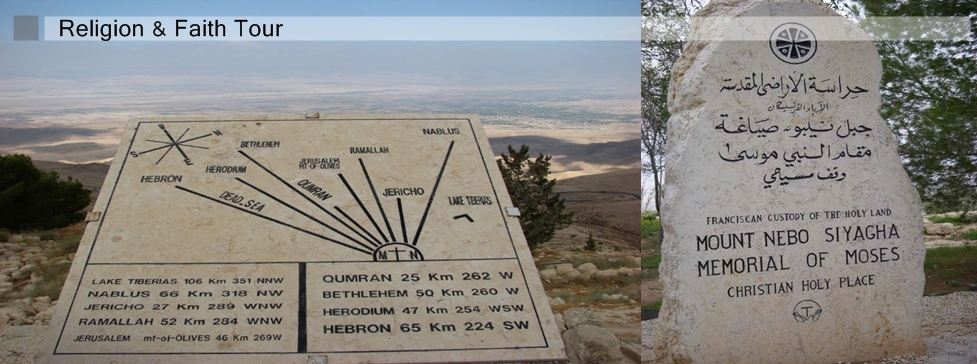
Religious Tours in Jordan
JABBOK RIVER: On the way to Jerash, stop at the Jabbok (Jacob) River which is mentioned in the Bible. Twenty years after the quarrel between himself and his brother Esau (grandchildren of Abraham and sons of Isaac), Jacob came back from Padan-Aram with his family and settled in this area. Here Jacob became involved in a fight with a stranger and won. Later on he found out that he had fought against God and God blessed him by decreeing that forthwith he should be named Israel (1 Moses 32:22 - 32).
ANJARA: Anjara's Catholic Church and the statute of the Virgin Mary holding baby Jesus. It is believed Christ passed through Anjara on a journey between Jerusalem and the Galilee.
SALT: The town is situated 29 km north of Amman and has no biblical background. Around 1975 a relief-decorated family grave with three sarcophaguses and many burial additions were found there. It could date from the 3rd century A.D. and represents the roman past of the city, which was named Gadora at the time. On one of the hills of the city, a fortress was built at the time of the Crusaders, which was used until Turkish dominion.
HISBAN: In the Bible, Hisban is named Heshbon - the city of the Sihon (4 Moses 21:25f, 32:37) and Heshbon was conquered by the Israelites (Judges 11:26).
MUKHAYAT: Scholars suppose this village to be the site of the biblical city of Nebo. In the middle of the 9th century B.C. King Mescha boasted that he had slain 7000 men, women, boys, girls and maids at this place and had taken it from the Israelites. In Byzantine times, Khirbet El Mukhayat had a monastery complex and at least four churches.
MUKAWIR: In the Bible, Mukawir is referred to as Machaerus. On a mountain which resembles a cone with its top cut off, can be seen the imposing remnants of the fortress Qasr El Mashneqh. The Arabic name means "Castle of Gallows". The castle was built by Alexander Jannaeus. The historian, Josephus, reports that it was here that John the Baptist was imprisoned, Salome danced and John was beheaded (Matthew 14:3 - 11).
DHIBAN: In the Bible it is referred to as Dibon. The town was taken from the Moabs by the King of the Amorites, King Sihon. Then King Sihon lost Dibon to the Israelites (4 Moses 21:25 - 31).
WADI MUJJIB: In biblical times, the Wadi, or River Arnon, formed the natural border between the territories of the Moabs in the north and the land of the Edomites (later the Nabateans) in the south. Even now it acts as the border between the two administrative districts of Balqa and Kerak. The Wadi is mentioned in the Old Testament (at the time of King David) as the river which flows through the valley to the Dead Sea.
RABBA: This is an old settlement with modern buildings. The history of Rabba probably began with the city Ar or Ar-Moab, which is mentioned in 4 Moses 21:15 and 5 Moses 2:9. While the Israelites of the Exodus spared Ar and the whole land Moab, the Amorite King Sihon ransacked the city in an attack launched over the Arnon River (4 Moses 21:28).
QASR: Today Qasr is a village with the remnants of an old arab castle, probably built in the 2nd century A.D.
KERAK: Kir, Kir-Moab and Kir-Heres are the Old Testament names for the town of Kerak (Isaiah 15:1, 16:7 and 16:11 and Jeremiah 48:36). In the time of the Judges, the Moabite King Eglon may have resided in Kir-Moab. In 850 B.C. one of his successors, King Mesha, was surrounded by the united Israel-Judah forces of Kings Jehoram and Jehoshaphat in Kir-Heres and could only escape defeat by sacrificing his first-born son.